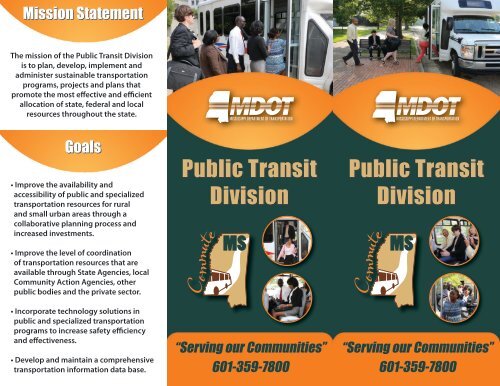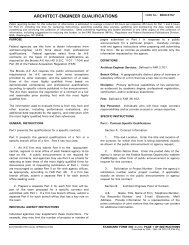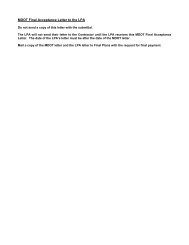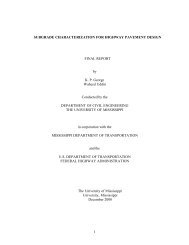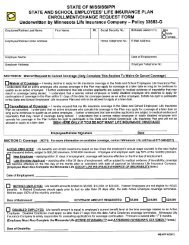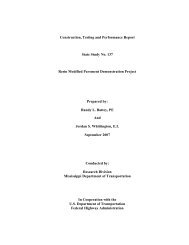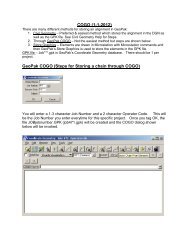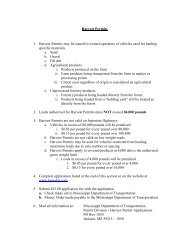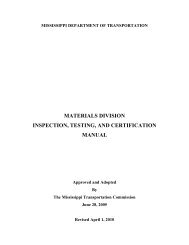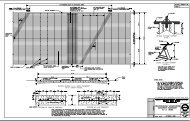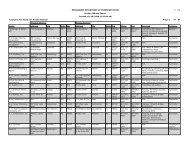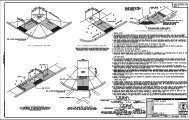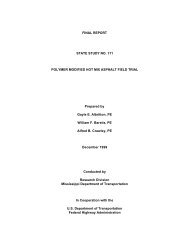Public Transit Brochure - Mississippi Department of Transportation
Public Transit Brochure - Mississippi Department of Transportation
Public Transit Brochure - Mississippi Department of Transportation
- No tags were found...
You also want an ePaper? Increase the reach of your titles
YUMPU automatically turns print PDFs into web optimized ePapers that Google loves.
Mission StatementThe mission <strong>of</strong> the <strong>Public</strong> <strong>Transit</strong> Divisionis to plan, develop, implement andadminister sustainable transportationprograms, projects and plans thatpromote the most effective and efficientallocation <strong>of</strong> state, federal and localresources throughout the state.Goals• Improve the availability andaccessibility <strong>of</strong> public and specializedtransportation resources for ruraland small urban areas through acollaborative planning process andincreased investments.• Improve the level <strong>of</strong> coordination<strong>of</strong> transportation resources that areavailable through State Agencies, localCommunity Action Agencies, otherpublic bodies and the private sector.• Incorporate technology solutions inpublic and specialized transportationprograms to increase safety efficiencyand effectiveness.• Develop and maintain a comprehensivetransportation information data base.<strong>Public</strong> <strong>Transit</strong>Co mmuteDivisionMS“Serving our Communities”601-359-7800<strong>Public</strong> <strong>Transit</strong>Co mmuteDivisionMS“Serving our Communities”601-359-7800
MDOT’s <strong>Public</strong> <strong>Transit</strong> DivisionThrough the Office <strong>of</strong> Intermodal Planning, MDOT is committed to coordinated planning and the collaborative allocation<strong>of</strong> local, state and federal resources to develop, implement and sustain transportation programs and projects.The <strong>Public</strong> <strong>Transit</strong> Division has as its’ primary responsibility the development and administration <strong>of</strong> general public andspecialized transportation program grants and contracts. These programs include service delivery, technical assistance,and training components. The Division administers U.S. <strong>Department</strong> <strong>of</strong> <strong>Transportation</strong> funds on behalf <strong>of</strong> the Federal<strong>Transit</strong> Administration (FTA) for rural and small urban areas <strong>of</strong> the state.DESCRIPTION OF PROGRAMSMAP-21 furthers several important goals, including safety,state <strong>of</strong> good repair, performance, and program efficiency.MAP-21 gives FTA significant new authority to strengthenthe safety <strong>of</strong> public transportation systems throughout theUnited States. The act also puts new emphasis on restoringand replacing our aging public transportation infrastructureby establishing a new needs-based formula program and newasset management requirements. In addition, it establishesperformance-based planning requirements that align Federalfunding with key goals and tracks progress towards thesegoals. Finally, MAP-21 improves the efficiency <strong>of</strong> administeringgrant programs by consolidating several programs andstreamlining the major capital investment grant programknown as “New Starts.” These, and other important changes,are summarized below:Rural Area Formula Grants (5311)This program provides administration, capital, planning,and operating assistance to support public transportationin rural areas, defined as areas with fewer than 50,000residents. Activities eligible under the former Job Accessand Reverse Commute (JARC) program, which providedservices to low-income individuals to access jobs, are noweligible under the Rural Area Formula program. In addition,the formula now includes the number <strong>of</strong> low-incomeindividuals as a factor. Funds may be used for planning,capital purchases, administration’ planning and operatingexpenses, and require a local match. Eligible recipientsinclude local public bodies, non-pr<strong>of</strong>it organizations andstate agencies.Intercity Bus ProgramThis program meets a federal requirement for assistance tobus operators in providing connecting services between nonurbanizedareas and larger regional or national bus routes.Appalachian Development <strong>Public</strong> <strong>Transportation</strong>Assistance ProgramThis program provides funding to support publictransportation in the Appalachian region <strong>of</strong> the state.Funds may be used for planning, capital purchases,administration’ planning and operating expenses, andrequire a local match.Enhanced Mobility <strong>of</strong> Seniors and Individualswith Disabilities (5310)Grants are made by the MDOT to private non-pr<strong>of</strong>itorganizations (and certain public bodies) to increasethe mobility <strong>of</strong> seniors and persons with disabilities. Theformer New Freedom program (5317) is folded into thisprogram. The New Freedom program provided grantsfor services for individuals with disabilities that wentabove and beyond the requirements <strong>of</strong> the Americanswith Disabilities Act (ADA). Activities eligible under NewFreedom are now eligible under the Enhanced Mobility <strong>of</strong>Seniors and Individuals with Disabilities program. Eligiblecapital costs include buses, vans, radios, computers,engines, and transmissions. Using these funds foroperating expenses requires a 50 percent local matchwhile using these funds for capital expenses (includingacquisition <strong>of</strong> public transportation services) requires a20 percent local match. At least 55 percent <strong>of</strong> programfunds must be spent on the types <strong>of</strong> capital projectseligible under the former section 5310. The remaining 45percent may be used for new freedom related programrequirements. Projects must be included in a coordinatedhuman service transportation plan.Bus and Bus Facilities Formula Grants (5339)This program provides funds to assist eligible recipientsdescribed in subsection (c)(1) in financing capitalprojects (1) to replace, rehabilitate, and purchase busesand related equipment; and (2) to construct bus-relatedfacilities. Eligible recipients under this section aredesignated recipients that operate fixed- route bus serviceor that allocates funding to fixed route bus operators.A designated recipient that receives a grant underthis section may allocate amounts <strong>of</strong> the grant to subrecipientsthat are public agencies or private non-pr<strong>of</strong>itorganizations engaged in public transportation. This is acapital grant which requires 20 percent local match.Rural <strong>Transit</strong> Assistance Program (RTAP)RTAP funds are used by the Division to providetraining, and technical assistance, support researchor demonstration projects, and enable contractors topromote transit as a mobility alternative.<strong>Transit</strong> Asset Management (5326)This program establishes new requirements for transitasset management by FTA’s grantees as well as newreporting requirements to promote accountability.The goal <strong>of</strong> improved transit asset management is toimplement a strategic approach for assessing needsand prioritizing investments for bringing the nation’spublic transit systems into a state <strong>of</strong> good repair. AllFTA grantees and their sub-recipients are required todevelop transit asset management plans that include, at aminimum:• capital asset inventories and condition assessments• investment prioritization.<strong>Public</strong> <strong>Transportation</strong> Emergency ReliefProgram (5324)This program helps states and public transportationsystems pay for protecting, repairing, and/or replacingequipment and facilities that may suffer or have sufferedserious damage as a result <strong>of</strong> an emergency, includingnatural disasters such as floods, hurricanes, and tornadoes.Eligible Recipients include: States and governmentalauthorities, including public transportation agencies.Emergencies are defined as natural disasters affectinga wide area or as catastrophic failures resulting froman external cause, and as a result, the governor <strong>of</strong> astate has declared as an emergency and the Secretary<strong>of</strong> <strong>Transportation</strong> has concurred, or the President hasdeclared a major disaster. The federal share for capitaland operating costs is 80%, with a 20% non-federal share,although FTA may waive the local match. The grants areonly for expenses that are not reimbursed by the FederalEmergency Management Agency (FEMA).


